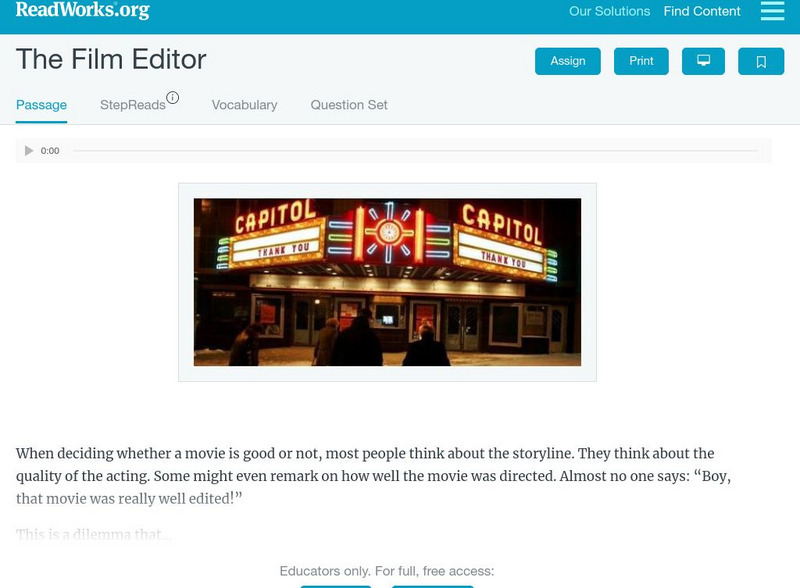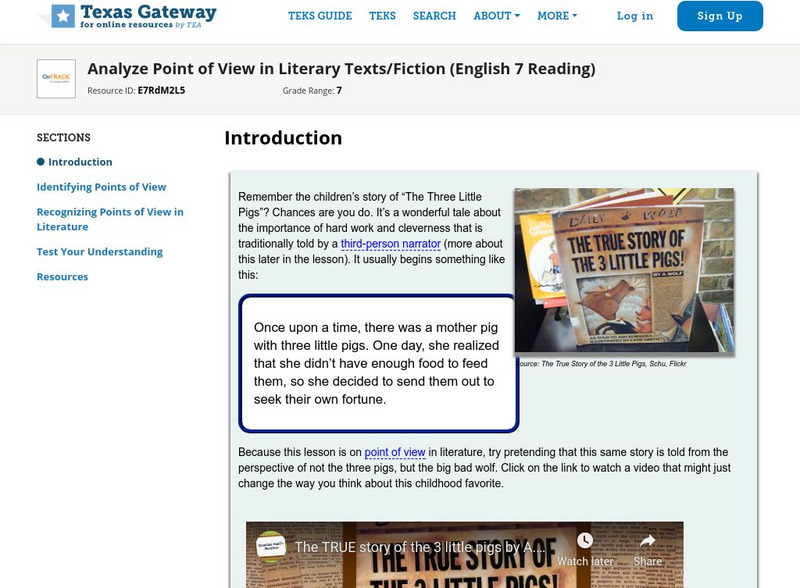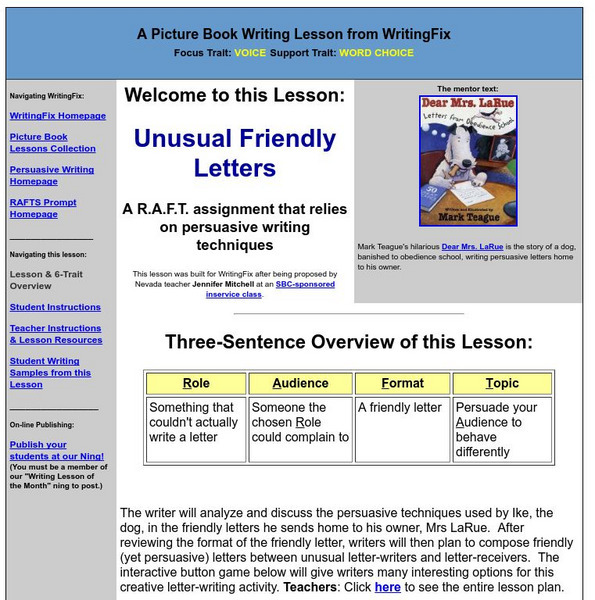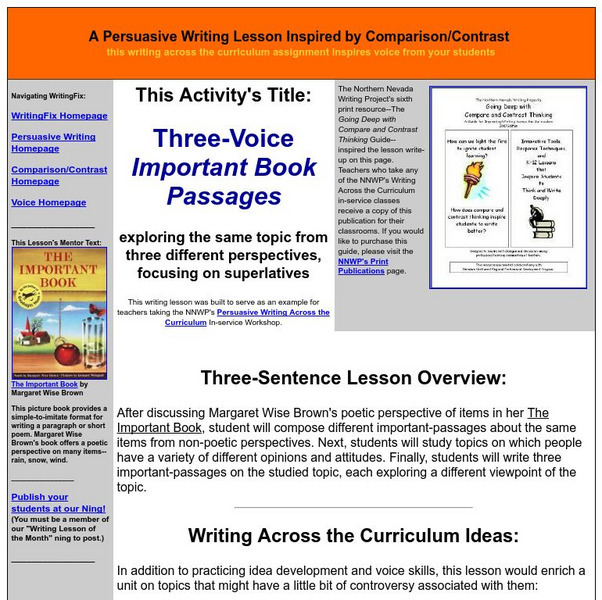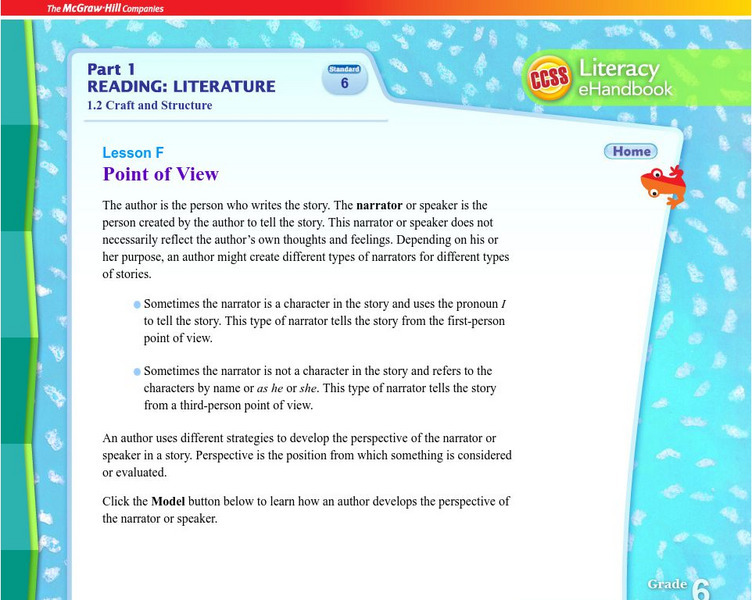Read Works
Read Works: Passages: The Mountain
[Free Registration/Login Required] Students read a fiction text about an unexpected love and answer questions about comprehension, setting, vocabulary, transitions, and more. A paired text and questions are also available.
Read Works
Read Works: Passages: The Process of Acting
[Free Registration/Login Required] Students read a nonfiction text about what it takes to be an actor and answer questions about comprehension, main idea, supporting details, vocabulary, transitions, and more. Links to a paired text and...
Annenberg Foundation
Annenberg Learner: Literature: Describing Setting
Short explanation of setting as a literary term. Written in the context of "What makes a good short story?" A link at the bottom of the page leads to additional information about setting.
Sophia Learning
Sophia: Selecting Topics for Literary Analysis
A series of resources designed to teach students how to write a literary analysis. The first is a screencast [6 mins] that focuses on defining and introducing the parts of a literary analysis. The second is a slide show with seven slides...
The Write Place
Literacy Education Online: Strategies for Revising and Editing on Computers
Comprehensive discussion on how to edit material on computers. Explains how to perform functions in 2 general areas: spell check and search & replace. Also explains difference between doing this "on paper" and on computer. W.11-12.6...
CommonLit
Common Lit: Where Did I Come From
CommonLit.org is a wonderful resource to use in a Language Arts classroom. Each story or article is accompanied by guided reading questions, assessment questions, and discussion questions. In addition, students can click on words to see...
Texas Education Agency
Texas Gateway:analyze (Describe) Point of View in Literary Texts/fiction
In this learning module, students will learn to analyze fiction told from the first-person, third-person limited, and third-person omniscient points of view.
Texas Education Agency
Texas Gateway: Analyze Point of View in Literary Texts/fiction
This lesson focuses on identifying points of view and recognizing points of view in literature.
Other
Hong Kong Polytech: Functions in Academic Writing
Provides a wealth of interactive exercises dealing mainly with the structuring of sentences in different kinds of academic writing.
Other
Carson Newman College: Close Reading of a Literary Passage [Pdf]
Provides a number of questions that students can ask themselves about a literary passage when doing a "Close Reading" and following this with an organized piece of writing. CCSS.ELA-Literacy.CCRA.R.5
Better Lesson
Better Lesson: Developing Characters and Experiences With Sensory Language
Adding sensory languages makes your writing so good you can see, hear, smell, taste and touch it. This lesson will show you how to use descriptive sensory language in order to develop and capture the experiences and characters in a...
Houghton Mifflin Harcourt
Holt, Rinehart and Winston: Writer's Model: Book Review Example 2
This three-page essay provides an example of an book review. Clicking on the "Writer's Guide" link in the upper right-hand corner of the page enables the user to get tips, directions, and explanations on the essay.
Houghton Mifflin Harcourt
Holt, Rinehart and Winston: Writer's Model: Autobiographical Narrative Example
This four-page essay provides an example of an autobiographical narrative. Clicking on the "Writer's Guide" link in the upper right-hand corner of the page enables the user to get tips, directions, and explanations on the essay.
AdLit
Ad lit.org: Teach the Elements of Writing
It's a misconception that writing teachers simply tell students to write and wait to see what happens. Teachers should provide instruction in and exposure to various elements of writing to help students understand what good writing is.
AdLit
Ad lit.org: Key Literacy Component: Writing
Students who don't write well aren't able to learn and communicate effectively. This article explains what good writing skills are and how to help struggling young writers gain those skills through proper instruction.
AdLit
Ad lit.org: A Summary of "Writing Next"
What does research tell us about effective teaching techniques to help adolescents develop their writing skills? This article summarizes Writing Next, a 2007 study of adolescent writing instruction.
Ted Nellen
Cyber English (By Ted Nellen): Characterization
This is a glossary entry for the term "Characterization" including a definition and the characteristics to be developed: Character's appearance, actions, thoughts, voice, and reaction from others.
Writing Fix
Writing Fix: Unusual Friendly Letters: Persuasive Writing Techniques
For this lesson, students will use active voice in regards to persuasion. Lesson incorporates the A R.A.F.T. strategy: role, audience, format, topic.
Writing Fix
Writing Fix: Serendipitous Character Descriptions
In this lesson, students create a unique character and develop a descriptive paragraph utilizing strong word choice.
Writing Fix
Writing Fix: Three Voice Important Book Passages
A lesson plan made for students to write from various perspectives regarding the same topic. The mentor text entitled The Important Book is used, as students become more familiar with voice, point of view, persuasive techniques and the...
Writing Fix
Writing Fix: What's Your Fifth Element?
In this lesson young scholars will write persuasively in regards to a 21st century object.
Writing Fix
Writing Fix: Emotions and Colorful Days
In this lesson students will learn to write descriptively.
E Reading Worksheets
E Reading Worksheets: Teaching Point of View
This teaching module provides a way to help students identify the point of view in a text. Essential point of view definitions and worksheets are provided. A multi-slide PowerPoint presentation is included that provides graphic...
Curated OER
Mc Graw Hill: Reading Literature: Craft and Structure: Point of View
This learning module focuses on point of view including the speaker or narrator, first and third person, perspective, and the thoughts and feeling of the speaker. It offers a model story with explanation and a practice story with questions.



